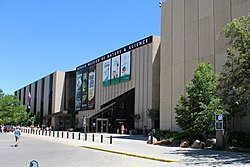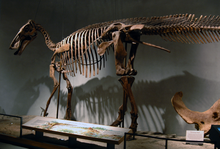
A | B | C | D | E | F | G | H | CH | I | J | K | L | M | N | O | P | Q | R | S | T | U | V | W | X | Y | Z | 0 | 1 | 2 | 3 | 4 | 5 | 6 | 7 | 8 | 9
 Denver Museum of Nature & Science | |
 | |
| Established | December 6, 1900 (123 years ago) |
|---|---|
| Location | Denver, Colorado |
| Type | Natural History |
| Visitors | 1,151,000 (2022)[1] |
| President | George Sparks |
| Website | www |
The Denver Museum of Nature & Science is a municipal natural history and science museum in Denver, Colorado. It is a resource for informal science education in the Rocky Mountain region. A variety of exhibitions, programs, and activities help museum visitors learn about the natural history of Colorado, Earth, and the universe. The 716,000-square-foot (66,519 m2) building houses more than one million objects in its collections including natural history and anthropological materials, as well as archival and library resources.
The museum is an independent, nonprofit institution with approximately 450 full-time and part-time staff, more than 1,000 volunteers, and a 29-member board of trustees. It is accredited by the American Alliance of Museums[2] and is a Smithsonian Institution affiliate.
In 2022, the museum received 1,151,000 visitors, ranking eighth in the List of most-visited museums in the United States. It was the fourth-most-visited U.S. museum of nature and science.[3] The museum's official online magazine is called Catalyst.[4]
Education programs
The museum provides programming in six main areas. The exhibitions, Infinity Theater films, lectures, classes, and programs pertain to one or more of the following core competencies: anthropology, geology, health science, paleontology, space science, and zoology. More than 300,000 students and teachers visit the museum with school groups each year. In addition, the museum has science outreach programs and distance–learning opportunities for families, schools and surrounding communities. The museum also offers ongoing professional training workshops for teachers.
History

In 1868, Edwin Carter moved into a tiny cabin in Breckenridge, Colorado, to pursue his passion, the scientific study of the birds and mammals of the Rocky Mountains. Almost single-handedly, Carter assembled one of the most complete collections of Colorado fauna then in existence.[5]
Word of Carter's collection spread and, in 1892, a group of prominent Denver citizens declared their interest in moving his collection to the capital city for all to see. Carter offered to sell the entire collection for $10,000. The founders also secured a collection of butterflies and moths, and a collection of crystallized gold.[6]
Together, these three collections formed the nucleus of what would become the Colorado Museum of Natural History, officially incorporated on December 6, 1900. After years of preparation and construction, the Colorado Museum of Natural History finally opened to the public on July 1, 1908.[7] John F. Campion, the first president of the board, said in his dedication address, "A museum of natural history is never finished". The first director was hired and quickly recruited staff to build more exhibits and create public programs. By 1918, another wing had opened and research efforts were well underway.
In 1927, a team led by the Colorado Museum discovered two stone projectile points embedded in an extinct species of bison, in Folsom, New Mexico. These Folsom points demonstrated that humans had lived in North America more than 10,000 years ago, hundreds of years earlier than previously believed.[8]
The city of Denver increased its funding for the museum, leading to a name change to Denver Museum of Natural History in 1948.[9] The name was changed again in 2000 to the present Denver Museum of Nature and Science, reflecting the institution's wider focus.[10]
The museum is partially funded by the Scientific and Cultural Facilities District (SCFD), which was created by area voters in 1988.[11] It has also attracted large donations from benefactors, such as Morgridge Family Foundation led by philanthropist Carrie Morgridge, which gave $8 million to the museum in 2010, described as being the largest single gift since its founding.[12]
Permanent exhibits
This section needs additional citations for verification. (September 2020) |


Expedition Health
Expedition Health teaches visitors about the human body, including the science of taste.[13] It opened on March 30, 2009, replacing the former Hall of Life.
Space Odyssey
Space Odyssey, which opened in 2003 and underwent a refurbishment in 2020, is about the Universe and our place in it. One major highlight of the exhibit is a full-scale replica of a Mars Exploration Rover, which was formerly found outside the exhibit from around 2004 to around 2016 or 2017.
Prehistoric Journey
Prehistoric Journey, which opened in 1995, traces the evolution of life on Earth. Displays include skeletons and skulls of prehistoric animals (synapsids, dinosaurs and others): Dimetrodon, Eryops, Allosaurus, Stegosaurus, Diplodocus, Edmontosaurus, Maiasaura, Megacerops, Archaeotherium, Hyaenodon, Merycoidodon, Stenomylus, Merycochoerus, Moropus, Dinohyus, Hesperotestudo, Gomphotherium, Synthetoceras and Teleoceras, a sea lily reef diorama from 435 million years ago, a cast/replica skull of the ancient placoderm fish, Dunkleosteus, and a collection of trilobites.[14]
Wildlife Halls
The Wildlife Halls are animal dioramas showing scenes of daily life of many different animals, one of the largest collections of its type in North America. The Wildlife Halls in the museum are:
Level 3 Wildlife Halls:
Birds of the Americas
Explore Colorado (also known as Explore Colorado: From Plains to Peaks)
Northern and Rare Birds (also known as Birds of North America)
South America (also known as Sketches of South America)
Botswana, Africa (also known as Africa-Botswana: Sharing a Fragile Land and Botswana: Safari to Wild Africa)
| Species and locations represented in Botswana: Safari to Wild Africa | ||||||||||
|---|---|---|---|---|---|---|---|---|---|---|
| Botswana | Chacma baboon | Rufus-crowned roller | Greater kudu | Sable antelope | Warthog | Red-billed francolin | Steenbok | Plains zebra | ||
| Northern Botswana | Lion | Yellow-billed hornbill | ||||||||
| Botswana | Sitatunga | Malachite kingfisher | Nile crocodile | Hippopotamus | ||||||
| Dung beetle | Cheetah | Impala | ||||||||
| Southern Botswana | Gemsbok | Zebra white | African monarch | Brown-veined white | Lemon traveler | Banded gold tip | Broad-bordered grass yellow | African orange tip | Springbok | Red hartebeest |
| Northern Botswana | African fish eagle | Red lechwe | Waterbuck | |||||||
| Botswana | Bat-eared fox | African civet | African porcupine | Giant eagle owl | Ratel or honey badger | Spring hare | African wildcat | |||
| Leopard | Common duiker | |||||||||
| Aardwolf | Aardvark | Cape pangolin |
Level 2 Wildlife Halls:
Bears and Sea Mammals (also known as Into the Wild: Bears and Sea Mammals and North America's Bears and Northern Sea Mammals)
| Species and locations represented in North America's Bears | |
|---|---|
| Aleutian Islands, Alaska | Brown bear |
| Yakutat, Alaska | Glacier bear |
| Gribbell Island, British Columbia | Spirit bear |
| Alaska | Barren ground grizzly |
| Archuleta County, Colorado | Grizzly bear |
| Yellowstone National Park, Wyoming | Black bear |
